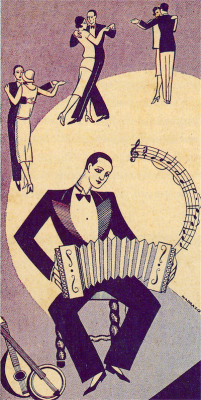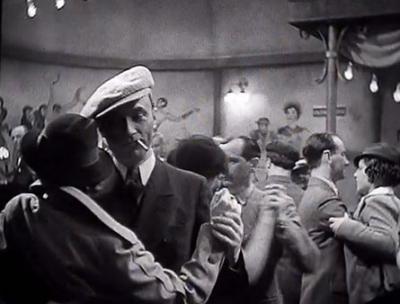- Historical Dance
- Jazz Age Social Dancing ("The Modern Dances")
- 0. The Essentials of Jazz Age Ballroom Dancing
- 1. Foxtrot Part 1: The Jazz Age Foxtrot
- 2. Youth Dancing in the Jazz Age
- 3. The Jazz Age Waltz
- 4. The Jazz Age Tango
- 5. 1930s Rumba
- 6. 1930s Samba
- 7. 1930s Conga
- 8. Bal Musette: Parisian Dance of the Jazz Age
- 9. Dancing in Weimar Berlin
- Dancing Made Easy - 1922
- Film Library - Jazz Age Dance
- Historical Dance Films posted to Pinterest
- Jazz Age Dance - Apologia
- Jazz Age Dance Image Collection
- Jazz Age Lead and Follow
- Places to Dance in Southern California in the Jazz Age
- Sampler of Jazz Age Dance Holds
- The Pathé Historical Dance Collection: 1920s-40s
- Ragtime Dance - the One Step
- Regency Dance
- Victorian Dance
- Jazz Age Social Dancing ("The Modern Dances")
8. Bal Musette: Parisian Dance of the Jazz Age
 I include this as a distinct heading, since Paris in the "Jazz Age", while absorbing the influences of the US and other countries, had its own distinctive style of dance. Given that Jazz Age Paris was the world capital of fashion, art and intellectual ferment, I think it appropriate that a survey of Jazz Age dance should take a moment to look at how people were dancing in the world of Chanel, Hemingway, Piaf and Picasso. The style of dancing seems to have persisted with very little change until the inexorable march of Rock and Roll eclipsed it in the '60s.
I include this as a distinct heading, since Paris in the "Jazz Age", while absorbing the influences of the US and other countries, had its own distinctive style of dance. Given that Jazz Age Paris was the world capital of fashion, art and intellectual ferment, I think it appropriate that a survey of Jazz Age dance should take a moment to look at how people were dancing in the world of Chanel, Hemingway, Piaf and Picasso. The style of dancing seems to have persisted with very little change until the inexorable march of Rock and Roll eclipsed it in the '60s.
While lumping it all under the title of "Bal Musette" may not be precisely correct, since there was plenty of dancing taking place in France in places other than Bals Musettes (upscale nightclubs, private parties etc. for example), it is a convenient shorthand for this distinctive French style.
A "Bal Musette" was an informal sort of dance, hosted in bars, restaurants and dance halls, open all to social classes and often with a decidedly down market feel. It was danced on a small dance floor with a modest band (trio, quartet, quintet) that nearly always featured a "musette" accordion.
The dances at these events would be the often quite fast Valse Musette, the bouncier waltz time Java (it sounds like a Waltz Mazurka to those with a Victorian dance background), the Tango the Foxtrot (as in America, a one-step dance adaptable of any 4-4 beat) and Latin dances such as a Paso Doble or Rumba. While Swing music, delivered by musicians like Django Reinhardt, was finding its way into Paris before the Fall of France in 1940 (to be danced as a lively Foxtrot), it does not appear that Swing dancing was much seen in France before the arrival of the Americans in the Liberation of 1944.
 These things stand out when looking at films of French dance of the Jazz Age.
These things stand out when looking at films of French dance of the Jazz Age.
1. In a time of close dance holds, the French danced very close together. Women's arms frequently encircled the men's necks, men often abandoned the conventional ballroom position for something more like a hug. With partners so intimately intertwined, steps had to be small and contained.
2. There was clearly no ONE way to dance at a Bal Musette. Styles ranged from walking, to shuffling, to rapidly spinning. In the videos, look at the principle dancers and then look at what all the other folks are doing around them. You generally see a variety of postures, steps and styles sharing a floor.
3. Jazz Age French dancing was cool, mellow and restrained and the steps and figures quite simple. The French were not into showing off, but were focused on the interplay between the partners. They usually set a step and stuck to it through the whole dance. They did't feel the need to "bust a move" in the middle of the dance, and certainly had no interest in impressing some theoretical audience.
In the sections that follow I will go into a bit more detail. I will particularly illustrate the two waltz variations: the Valse Musette and the Java with a little bit about the Tango and Foxtrot.
Some Bal Musette Touches.
In looking at films and other depictions of the working class culture of the Bal Musette, there are a few recurring bits of background atmosphere.
- Men could be real jerks. The film depictions of the time show a lot of men giving peremptory head gestures and finger snapping to summon their women. It's easy to see the world that spawned the Danse Apache
- Those who were a bit more polite still used very informal ways of asking to dance. Some phrases I have picked out are "Allez au danse?"(Go to dance?), "Et danser?" (..and dance?) and "Venez danser?" ("Come dance?")
- Dress was, by the standards of the Jazz Age, informal (guys with open collars and no ties, or turtlenecks).
- Men often kept their hats on.
- Just because you were dancing didn't mean you had to abandon your cigarette.
- Women could ask men to dance.
- Women could dance with women, but in all but the most open-minded establishments, men couldn't dance with men.
- When the guy came around to collect the cover charge tokens, the women often paid.
Here's a selection of French dance images.
Click on the links below for videos and more detail
